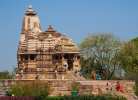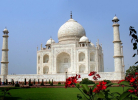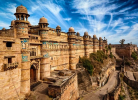Tomb of Akbar, Agra
-
Famous For History Buffs, Photo Fanatics
-
Duration of Visit 1 to 2 hours
-
Fee INR 30 for Indians and INR 310 for Foreigners
-
Visiting Time All days of the week 6:00 AM - 6:00 PM
Akbar is one of the prominent rulers of Mughal dynasty. He was the reason for the glory and development that Mughal reign had in art, architecture and trade. Akbar’s mortal remains are located in Sikandra, inside Akbar’s tomb. Today, this tomb is an important tourist attraction of Agra.
History of Akbar’s Tomb
Akbar fell ill to dysentery (a deadly disease during 17th century) when he was in his 60s. He was ill for a couple of weeks and died without recovering. While on his dead bed, he planned many elements of his tomb, even the location of it. After his death in 1605, his son, Jehangir took the work of building his tomb and completed in 1613. When Akbar planned his mausoleum, he considered a huge garden with red sandstone tomb covered by grand gates. However, his plans were incomplete when he died. Jehangir took the plans, added more designs and models to the plan.
During Jehangir’s grandson, Aurangazeb’s rule, the Jats of surrounding regions entered Agra, invaded it and ransacked Akbar’s tomb. They plundered all the jewels from many monuments. As an act of revenge for Akbar killing Jat’s king Gokula, his son Raja Ram opened the grave of Akbar, dragged the bones out of the grave and burnt them. This is considered an act of disrespect. Thus, Aurangazeb captured Raja Ram and killed him.
The mausoleum underwent tremendous repairs and restoration during 1905, under the governance of Lord Curzon.
Location of Akbar’s Tomb
This mausoleum covers 119 acres in Sikandra, a suburb of Agra, in Uttar Pradesh. Sikandra is located on the Mathura Agra Road, around 8 km away from the center of the city. Just one kilometer away from Akbar’s tomb, tomb of Jehangir’s motheris located (Mariam’s Tomb).
Architecture of Akbar’s Tomb
During his rule, he gave equal importance to both the religions, Islam and Hinduism. His marriage to Jodha Bai of Rajput added more value to Hinduism in Mughal’s reign. This is why; his tomb was built with a combination of Islamic and Hinduism architecture. Of all the gates of the tomb, the southern gate is the largest one. The gate is called as Buland Darwaza, which means the gateway of Magnificence.
The gate has an archway with four minarets, which are made of white marble and topped with chhatri. It is very similar to Taj Mahal, which was built many decades later. If you pay closer attention to the gate, you will find geometric floral patterns in white marbles. Calligraphic designs are made in large mosaic patterns.
The tomb is surrounded by walled enclosure and a garden lies within it. The garden surrounding the monument is fed with water canals. You can spot monkeys and deer in the garden. Once you enter through the southern gate, you will reach the garden. Walk through the garden to enter the Akbar Tomb. The four causeways on the garden will lead to the tomb. The arcaded verandas, cubicles and pyramidal roofs of the tombs are its significant features along with fine jali work and calligraphic patterns.
The ground floor holds a verandah styled architecture and the first floor has the cenotaph, which is said to be carved from a single slab of marble. 99 names of Allah are inscribed on it, just like the grave of Mumtaz Mahal in Taj Mahal. The first floor is made entirely with marble and the ground floor is made with red sandstone.
The tomb is actually a pyramid with five tiers. The pyramid is mounted on a marble pavilion. The actual tomb of the mausoleum is located in the basement and the one seen above is the façade one. The building is mainly constructed with red sandstone and white marble. Inside the tomb, you can find geometric panel designs of floral, complex figures, calligraphic and subtle designs.
There is a small room inside the mausoleum, which holds the cenotaph. It is called as sober room. The actual grave is located in the basement, which is closed to tourists now. It was said to be filled with precious gems and articles before the Jats looted it clean. Today, the mausoleum holds two graves belonging to the daughters of Akbar and two more graves of Aurangzeb’s daughter and son-in-law.
All the Mughal mausoleums face towards Mecca. However, this mausoleum faces the opposite side, towards the east. The storey right above the burial room is filled with arcaded verandahs and chhatris. The second and the third floors of the pyramid structure is filled with cubical rooms. The last floor holds the cenotaph. The walls of cenotaph floor are made with jali work.
The inner walks to the tomb are painted with stucco painting. This style of painting uses green, gold and blue color paints and decorations using Persian inscriptions. It is said the Jehangir used similar designs to decorate his chambers.
How to Reach Akbar’s Tomb
The mausoleum is located in Sikandra. You can find buses from Agra to Mathura from Bijli Ghar bus stand. The buses will pass through the mausoleum on the route. You can also choose to hire auto or taxi from any part of the city. If you are visiting from any other city or state, reach Agra and then, find road transportation to Sikandra.
Best Time to Visit Akbar’s Tomb
The tomb is open from sunrise to sunset. However, tourists prefer to visit this monument in the morning, usually. If you reach by early in the morning, you can watch the eastern part of the monument being gradually illuminated by the morning sun as it reaches its pinnacle. You can find winter to be more pleasing and comfortable than summer and monsoon. Winter starts in October and ends in March.
Entry Fee and Timing of Akbar’s Tomb
Tomb Is Open from Sunrise To Sunset and entry fee are given below:
- Entry Fee For Indians – INR 30 Per Head
- Entry Fee For SAARC Citizens – INR 30 Per Head
- Foreigners – INR 310 Per Head
- Children Below 15 Years Of Age – NIL
- Cost Of Video Camera – INR 25
















